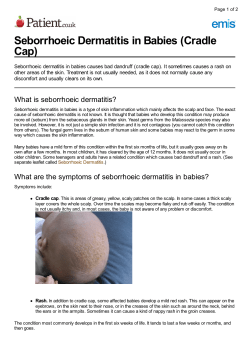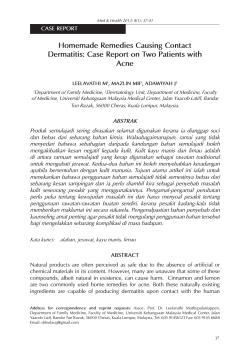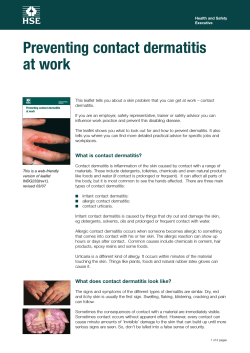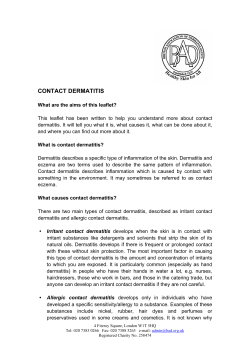
COMMON CHILDHOOD RASHES
COMMON CHILDHOOD RASHES Chan Poh Chong In approaching the problem of common skin conditions in children, we need to go through a history and physical examination, before deciding on whether any investigations are necessary to come to a diagnosis. Treatment is then instituted, or as in many cases in paediatric dermatology, reassurance may be all that is needed. Referral to a paediatric dermatologist should be considered if the diagnosis is unclear or specialist treatment is required. Some of the common skin conditions are listed below: • • • • Diaper dermatitis Neonatal skin lesions Common childhood eczema Common childhood infections • Common childhood infestation • Other dermatosis • Lesions with malignant potential 1 Bulletin 38 November 2004 MITA (P) No: 275/05/2003 Diaper dermatitis is a general term that indicates dermatoses of the anogenital region, some common causes include: • • • • Irritant contact dermatitis (True diaper dermatitis) Seborrhoeic dermatitis Candidiasis Psoriasis Irritant contact dermatitis occurs in 50% of infants to some degree and 50% of these are severe. It peaks at the age of 9 - 12 months, presenting with redness, papulo-pustular eruption, ulcers and erosions. Moisture around the groin leads to friction, abrasion and fungal growth. This form of dermatitis spares the skin folds around the inguinal and thigh region. Treatment includes frequent application of a barrier cream, like zinc oxide and air-drying the groin area. Candidal diaper dermatitis is commonly due to infrequent diaper change and the use of antibiotics for other conditions. It presents with beefy red plaques with satellite papules/pustules affecting the groin folds. Investigation using potassium hydroxide on the scrapings of the lesions will reveal hyphae under the microscope. Management requires frequent diaper change and use of barrier creams after each diaper change. Imidazole creams are the mainstay of treating this fungal skin infection but use of 1% hydrocortisone et vioform may be needed for more inflammatory lesions. Seborrhoeic dermatitis is a scaly, greasy and erythematous eruption involving the scalp, nasolabial folds and flexural regions of the child. It typically starts two weeks of age and clears within two months. It is usually asymptomatic and the child is otherwise well. Some authorities have considered seborrhoeic dermatitis as a variant of atopic dermatitis. This skin lesion maybe colonised with candida. Treatment using olive oil and baby shampoo with gentle scrubbing usually removes the lesion quite well. The cutaneous lesions are treated with 1% hydrocortisone et vioform or imidazole cream, as the anti-fungal medications have great anti-inflammatory properties as well. In severe, recurrent seborrhoeic dermatitis, one should consider Langerhan Cell Histiocytosis. Psoriasis presents as well demarcated red plaques with silvery scales over the groin, the trunk and the scalp. There is usually a family history of psoriasis. Treatment is with coal tar shampoo for scalp and body lesions, and judicious use of mid-potency corticosteroids may be required in certain cases. Referral to a dermatologist would be advisable for more severe lesions. Neonatal skin lesions are common conditions seen in the general practitioner setting. Most neonatal skin lesions are transient conditions that only require reassurance from the doctor, as long as the child is well and unaffected by the condition. The two common skin problems seen are erythema toxicum neonatorum and miliaria. 2 Bulletin 38 November 2004 MITA (P) No: 275/05/2003 Erythema toxicum neonatorum occurs in up to 50% of newborns during the first few days of life and lasting for up to six weeks before disappearing. They present as yellow or white papules and pustules on a red urticarial edematous base. They are seen on the face, trunk and limbs. The baby will appear well without any symptoms. Differential diagnosis includes staphylococcal infection, varicella neonatorum and herpes simplex. Miliaria is a skin condition due to the blockage of eccrine sweat ducts in the epidermis. Miliaria crystalline, the superficial form, presents as clear, thin-walled vesicles 1 2mm in size and would usually rupture with desquamation. It can be found on the head, neck and trunk, in the first two weeks of life. Miliaria rubra, the deep variant, is also commonly known as “Prickly heat”. They show up as erythematous papules or papulovesicles, each 1 - 4mm in diameter, on the neck, groin, axilla and other flexural areas. They can be recurrent, occurring intermittently up to childhood. Differential diagnosis includes infantile acne and follicultitis. Common childhood eczema include: • Atopic dermatitis • Seborrhoeic dermatitis • Juvenile plantar dermatosis Atopic dermatitis presents as chronic, relapsing, pruritic lesions distributed characteristically depending on the age group. There is usually a positive family history. with >50% of children affected when one parent is affected. 80 - 90% of atopic dermatitis begins before six years old with 60 - 70% in infancy. 10% persist into adulthood with 80% of them being the severe, recalcitrant type. Triggers of flare-ups include irritants, hot and humid (sweat) environment, the use of woolen or nylon fabrics, allergens like house dust mite, animal dander and pollen. Secondary infections with staphylococcus aurues and herpes simplex may be severe. Psychological factors like stress can also trigger the lesions. The acute type presents with red, papulo-vesicular and weepy lesions. The subacute forms are erythematous papules and plaques, while the chronic type shows dry, lichenified lesions, with excoriation and hyperpigmentation. The infantile stage of atopic dermatitis is seen on the face, especially on the cheeks. They are dry, scaly and red with occasional oozy lesions. Infra-auricular fissures are known to be diagnostic. The childhood stages go through two phases. The early childhood lesions occur on the extensors of the limbs and the trunk, while the older child and adults have their lesions on their flexures, neck, ankles, cubital and popliteal fossae. Pen-orbital areas are also commonly seen. Other features like xerosis, icthyosis and pityriasis alba may be considered as part of atopic eczema. The mainstay of treatment of atopic dermatitis is using preventive measures to prevent flare-ups, and these include the use of emollients and moisturizers. Appropriate topical steroids are necessary for acute flare-ups. Antthistamines like chlorpheniramine and 3 Bulletin 38 November 2004 MITA (P) No: 275/05/2003 hydroxyzine for pruritus are important preventive measures. The use of antibiotics is warranted in infected eczema lesions. Eliminating the trigger factors are also important. Topical immuno-modulatory agents like pimecrolimus and tacrolimus have recently been used for their steroid sparing properties. Phototherapy, oral cyclosporine or mycophenolate should be done under the watchful eyes of paediatric dermatologists. Juvenile plantar dermatosis is common dermatitis of childhood affecting the forefoot presenting as dry, glazed, and pink erythema. They are symmetrical and there is usually pain from the fissures on walking. Treatment is with moisturizers like aqueous cream, urea cream or white soft paraffin. Antibiotic creams, eg. tetracycline ointment for fissures may be required. Mild steroid ointment is necessary for nore severe lesions and this dermatosis usually resolves after a few years. Common childhood infections include: • Impetigo • Candidiasis • Molluscum contagiosum • Herpes simplex, varicella • Hand-foot-mouth disease • Other viral illnesses Impetigo is a superficial vesicle/bulla skin condition with honey-yellow crusting and is often misdiagnosed as eczema on the neck and face. Staphylocoocu aureus, and occasionally Group A 3-hemolytic strep are the culprits. Oral antibiotics like cloxacillin and cephalexin are good choices to use. Topical mupiroçin or tetracycline may be considered for minor lesions. Recurrent impetigo may suggest a carrier status, either in the patient or his/her carer. The complication of staphylococcal scalded skin syndrome is fortunately, rare. Candidiasis presents as erythematous, eroded plaques with marginal scales and satellite lesions in the groin, scrotum, neck and axilla. Oral thrush occurs commonly in the young infants. Treatment is to exclude and treat predisposing causes like diarrhoea and the use of oral antibiotics. Topical imidazole works best and oral nystatin / miconazole oral gel should be used for oral thrush. Molluscum contagiosum is a common viral infection in childhood, caused by a DNA poxvirus. They present as small, pearly papules with central umbilication and cheesy material is extruded on squeezing. They occur in crops and autoinnoculation is a common way of spreading to the rest of the body. They last for months and would eventually disappear. Treatment for earlier resolution incudes Collomac (lactic/ salycylic acid), Cryotherapy, Trichioracetic acid (TCA), Silver nitrate caustic applicator - chemical cautery, Cantharidin (blistering effect) and Curettage. Imiquimod (AldaraTM) is a new alternative anti-viral treatment for this condition. 4 Bulletin 38 November 2004 MITA (P) No: 275/05/2003 Herpes Simplex (HSV) is due to the HSV virus type I. In childhood, herpetic gingivostomatitis occurs as grouped vesicles. Neonatal herpes simplex infection occurs during passage through the birth canal of an infected mother. Disseminated infection can be fatal. Children with severe atopic dermatitis, eczema herpeticum, a disseminated form of HSV infection can occur. Treatment is supportive as this is a self-limiting disease. Systemic anti-virals (acyclovir, valaciclovir) are used for severe infections like, neonatal herpes, eczema herpeticum, and in immunocompromised children. Varicella (VZV) can occur as primary infection - varicella zoster. This virus has a 7-21 day incubation period. Prodrome precedes the urticarial papules and vesicles. A typical “dew-drop on rose petal” appearance can be seen occurring from the onset. Complications like pneumonitis and encephalitis are not uncommon. Treatment is with oral or systemic acyclovir. Vaccination is available for all children more than a year old. Reactivation varicella, known as herpes zoster occurs as grouped papules and vesicles along dermatomal distrtibution. Acyclovir shortens the course and is usually used when there is ophthalmic involvement or in the immunocompromised child. Hand-foot-mouth disease is due to Coxsackie Al6 virus entering via the enteric route. The incubation is three to five days, with lesions occurring in the mouth as vesicles/ erosions. Palms, soles and buttocks may show blisters. Treatment is supportive. Other viral exanthems that occur commonly in children are Erythema infectosum (Fifth disease), Roseola infantum (Exanthem subitum), Measles, Rubella, Enteroviruses - echo, coxsackie and Ebstein-Barr Virus causing Infectious Mononucleosis (IMS). Common childhood infestation like scabies and lice have been on the decline in Singapore due to better hygiene standards. Scabies is caused by a mite; Sarcoptes scabei. The patient presents with nocturnal itch over finger webs, wrists, side of hand, axilla, groin and thighs. Scabies in children usually affect the region below the neck, but may also be seen above it. Scabetic nodules are commonly seen in the axilla and scrotum. Acropustulosis can occur after treatment, as an immune reaction to the treatment using topical steroid. Treatment for those < two years old is with 1% pemethrin cream x one day or sulphur in soft paraffin. For those 2 to 12 years old , 0.5% malathion x two - three days would suffice. Benzyl benzoate 5 or 10% x three days is another alternative. Pediculosis - head lice (pediculosis capitis), pubic lice (pthirus pubis) and body lice (pediculosis corporis) - are treated with 0.5% malathion (Derbac) and left overnight. They are wash off the next day and the treatment repeated one week later. Lichen striatus is a common linear eruption in childhood, occurring at a mean age of five years old. They are grouped small papules along a line, usually the extremity. This condition is idiopathic and resolves in one to two years olds with initial hypopigmentation. Topical steroids are helpful for the itch. 5 Bulletin 38 November 2004 MITA (P) No: 275/05/2003 Lichen nitidus is a chronic, self-healing eruption presenting as multiple pin-head size skin coloured papules, aggravated by sun exposure, on the extremities, trunk and face. Histology shows granulomas, and no treatment but reassurance is all that is needed, as they resolve in two to three years. Lesions with malignant potential are congenital Melanocytic naevus and Naevus sebaceum. Small (<5mm), medium (5 - 20mm) and giant (>20mm) Melanoytic naevi may occur, with a giant naevus having a 6 - 8% risk of transforming into malignant melanoma. Naevus sebaceum is a pilosebaceous gland malformation, presenting at birth as a circumscribed yellowish hairless plaque, which becomes warty during puberty. They have a 5% risk of basal cell carcinoma and treatment is excision before puberty, or better, before six months of age, as healing would more satisfactory. In conclusion, though many childhood skin conditions are transient or are easily treated, accurate diagnosis is of paramount importance. If there is any doubt, referral to a dermatologist must be considered. 6 Bulletin 38 November 2004 MITA (P) No: 275/05/2003
© Copyright 2025





















